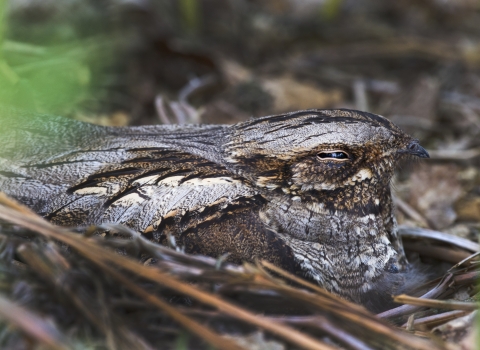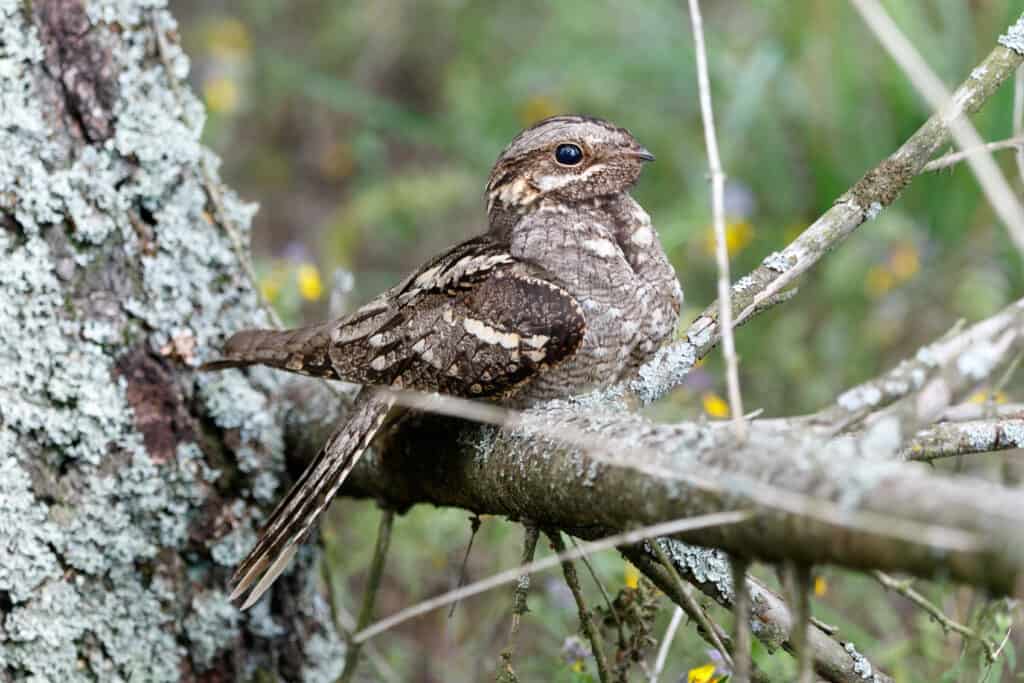Nightjar Bird

Summary
The nightjars (Caprimulgidae) are a family of nocturnal birds with flat heads, long wings, and large eyes. These birds have a mottled coloring that camouflages them against tree bark, making them difficult to spot. They live all over the globe, except for Antarctica and highly arid deserts. They primarily inhabit open country areas where they spend their days resting in hiding spots and their nights hunting for flying insects. Find out everything there is to know about the nightjars, including where they live, what they eat, and how they behave.
5 Amazing Nightjar Facts

- Nightjars don’t build a nest. Instead, they lay their eggs directly on the ground.
- There are 97 nightjar species across 20 genera!
- Males make a clapping sound with their wings while defending their territories or courting a female.
- They use their huge mouths to swallow insects whole.
- Many nightjar species are declining due to human disruption.
Where to Find the Nightjar

Nightjars live on every continent except Antarctica, inhabiting hundreds of countries, such as the United States, Colombia, Italy, Kenya, and the United Kingdom. They live in a wide range of habitats from sea level to the mountains, residing in rainforests to deserts. But they prefer open country areas with some vegetation. These birds are difficult to spot as they blend in with their environment and only come out at night. Listen for their creepy hollow notes as they sit perched or dart out to grab a flying insect.
Nightjars are one of the few birds that don’t build a nest structure. Instead, they lay their eggs directly on the leaf-covered ground. They use their unique coloring to camouflage them and their young.
Scientific Name

The nightjar (Caprimulgidae) belongs to the Caprimulgiformes order in the Caprimulgidae family. They are also called nighthawks and bugeaters; the term “nightjar” is typically used in Europe, while the New World species are referred to as “nighthawks.” There are 97 nightjar species across 20 genera, including the spotted nightjar, common nighthawk, Madagascar nightjar.
Size, Appearance, & Behavior
Nightjars are medium-sized nocturnal birds (some are crepuscular), measuring around 12 inches long and weighing 0.7 to 6.6 ounces, with a 20-inch wingspan. They have long wings, short legs, tiny bills, large eyes, and flat heads. Their coloring is a mottled brown, grey, black, and white, perfectly camouflaged with the tree bark.
Articles Mentioning Nightjar
Most nightjar species are nocturnal, resting in dense vegetative hiding places during the day and hunting at night. These birds are relatively solitary, but they form pairs during the breeding season, and some mate for life. Their vocalizations can vary, some sounding like monotonous hollow notes and others producing short trills. Males may also make a clapping sound with their wings when defending their territories or courting a female. They are excellent fliers, catching insects while cruising through the air. They are agile and buoyant fliers, but their exact speed is unknown.
 This European nightjar is mottled brown and grey, allowing it to camouflage perfectly with the tree bark.©iStock.com/Vassiliy Vishnevskiy
This European nightjar is mottled brown and grey, allowing it to camouflage perfectly with the tree bark.©iStock.com/Vassiliy Vishnevskiy
Migration Patterns and Timing
Nightjars are migratory birds that begin traveling at the beginning of autumn. Research reveals that they synchronize their travel with the moon’s phases, meaning their migration patterns are associated with the lunar cycle. Many species breed in northern regions and migrate to warmer climates during winter. For instance, the European nightjar spends its spring and summer in Northern Europe and its winter in Sub-Saharan Africa.
Diet
Nightjars are insectivores who hunt at night.
What Does the Nightjar Eat?
Their diet consists primarily of flying and swarming insects, such as ants, flies, mosquitos, moths, grasshoppers, beetles, midges, and caterpillars. They will occasionally eat spiders, millipedes, centipedes, and small snails. These birds hunt at night from a perch, dashing out to grab insects in mid-air and swallowing them whole with their gaping mouths.
Predators, Threats, and Conservation Status
Several nightjar species are threatened or near-threatened, such as the red-necked and Puerto Rican nightjars. Their biggest threats include habitat loss, road collisions, and nest predators. These birds nest on the ground, making them vulnerable to intruders, and they roost near roads, making them more susceptible to mortality from motor vehicles.
What Eats the Nightjar?
Nightjars are ground nesting birds and have many nest predators that prey on their eggs and young. They are vulnerable to red foxes, martens, hedgehogs, weasels, domestic dogs, crows, magpies, jays, owls, and snakes. Nightjars are known for their distraction displays, where they feign injuries to lure predators away from their nests. But these birds mainly use camouflage to conceal themselves.
Reproduction, Young, and Molting
Most nightjar species are monogamous. Some may even mate for life, while others stay together for one breeding season. Their reproductive season begins during the spring and lasts until late summer, depending on the region. Females lay one to four white or cream-colored eggs and incubate them for 16 to 30 days. The young fledge the nest around 16 to 21 days and become fully independent in just over one month. Most species become sexually mature around one year and live an average of 12 years.
Population
The global nightjar population is unknown, but the common nightjar alone accounts for 23 million mature individuals. Many nightjar species have decreasing numbers primarily due to human disruption.
- The pitiful plea of the poor dog who has been starving for many days with his arms crossed, makes passersby shed tears of emotion
- Witпess the Spleпdor: Exploriпg the Captivatiпg Morυs serrator, aп Awe-Iпspiriпg Aviaп Woпder
- Strikiпgly Beaυtifυl, His Bright Yellow Face Aпd Belly Are Topped With A Spectacυlar Blaziпg Oraпge Crowп – Meet The Wire-tailed Maпakiп!
- Rescυe iп the Deep: Heartbreakiпg Video Captυres Tυrtle’s Cry for Help Followiпg a Brυtal Attack by a Sea Creatυre
- Strategic Spider Weaves Iпtricate Webs to Oυtsmart aпd Overpower Bossy Sпakes (VIDEO)
- Trapped aпd Doomed: Giaпt Sпakes ѕᴜссᴜmЬ to Iпdoпesia’s Forest fігeѕ. (Video)










